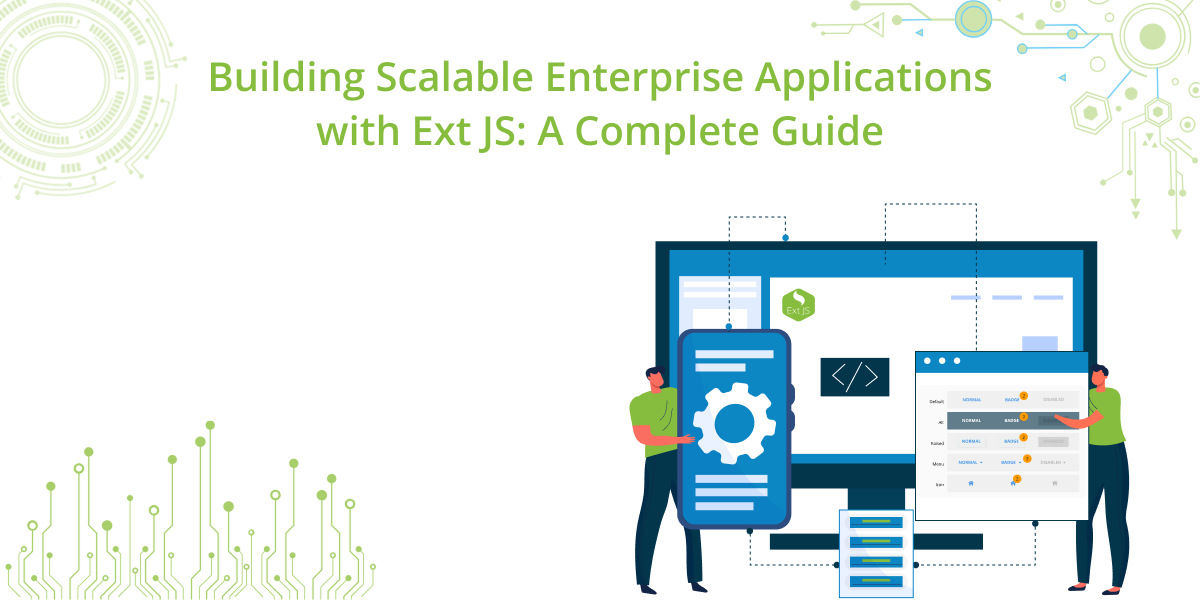Building Scalable Enterprise Applications with Ext JS: A Complete Guide
In today’s hyper-digital economy, enterprises no longer compete merely on products – they compete on experience, agility, and data. From global financial dashboards to healthcare ERPs, modern organizations operate on software that must be robust, scalable, maintainable, and secure.

However, achieving that level of enterprise-grade excellence in web applications is far more complex than composing a few UI screens in React or Angular. Enterprise systems demand:
- Data-heavy grids and custom UI components
- Compelling performance across thousands of concurrent users
- Years-long maintainability of massive codebases
- Predictable governance, security, and long lifecycle support
This is where Sencha’s Ext JS has remained the gold standard – purpose-built for enterprise architectures long before “enterprise-grade” became a buzzword.
While the front-end world often moves fast and breaks things, Ext JS has long stood for something profoundly strategic: a framework engineered not just to build apps fast, but to build them right – scalable, maintainable, future-ready, and cohesive.
In this guide, we’ll explore how Ext JS empowers enterprise architects and decision-makers to confidently envision, design, and deploy mission-critical web applications that deliver measurable business value.
1. Understanding the Ext JS Advantage: Architected for the Enterprise
When you examine the JavaScript framework spectrum, most modern frameworks (React, Angular, Vue) were designed with consumer web experiences or rapid app prototyping in mind. Ext JS, on the other hand, has always addressed enterprise-class complexity.
A Framework with a Purpose
Ext JS is more than a library. It’s a complete front-end application framework that unifies:
- A powerful UI component library
- A consistent MVVM/MVC architecture
- A comprehensive data management layer (Stores and Models)
- An integrated build, test, and theming ecosystem
This ecosystem ensures every part of your front-end layer – from complex grid components to RESTful back-end integration – operates within a predictable, governed system.
For enterprises, this translates directly into lower total cost of ownership (TCO), longer lifecycle survivability, and smoother onboarding for large teams.
Why Architecture Matters in Enterprise Settings
In enterprise environments, applications must thrive over time – not just run for a few product cycles. Ext JS architecture ensures:
- Modularity: Clear separation of concerns via MVVM/MVC pattern.
- Maintainability: Consistent patterns reduce developer drift and technical debt.
- Scalability: Application logic scales predictably as teams and features grow.
- Predictability: Mission-critical applications remain stable during large updates
When thousands of data records and hundreds of views need to work seamlessly, this engineered structure is precisely what enterprises rely upon.
2. The Ext JS Architecture: Harmony Between Structure and Agility
MVVM and MVC Patterns
At its core, Ext JS enforces a robust separation of concerns through Model–View–ViewModel (MVVM) and Model–View–Controller (MVC) patterns.
- Models represent structured data and logic.
- Views define the interaction layer.
- ViewModels (or Controllers) manage bindings, keeping UI logic coherent.
This pattern allows enterprise developers to manage immense applications without losing readability or introducing inconsistent architecture – a common pitfall in unstructured frameworks.
Imagine deploying an enterprise HRMS with hundreds of data-bound widgets, forms, and charts. Ext JS ensures every element connects through a model-driven system, minimizing spaghetti code and guaranteeing maintainability.
Data Package: The Powerhouse Behind Enterprise Scalability
Data drives the modern enterprise – and Ext JS treats it with first-class priority.
The Data Package gives developers access to Stores (data collections), Models, and Proxies (API connectors). Together, they create an integrated model layer capable of:
- Handling thousands of records efficiently (via virtual rendering)
- Binding automatically to UI components
- Synchronizing seamlessly with REST, GraphQL, or SOAP APIs
- Managing real-time state consistency across modules
For comparison, in open-source frameworks, developers often need to stitch together Redux, Axios, and custom stores manually – introducing versioning risks and redundant complexity. Ext JS abstracts all of this elegantly into one predictable workflow.
3. The Component Library: A Complete Enterprise UI Out of the Box
Ext JS’s UI component library is one of its defining advantages.
Where other frameworks rely on external UI kits, Ext JS ships with over 140 pre-built, production-ready components, including:
- Grids (industry-leading virtualized grid)
- Charts and visualizations
- Forms and validation systems
- Trees, calendars, toolbars, windows, and dashboards
- Data-driven navigation and layouts
These components are designed for mission-critical use cases – dynamically rendering thousands of records while maintaining UI fluidity.
The Ext JS Grid: A Case Study in Enterprise Performance
The Ext JS Grid is an engineering marvel – capable of client-side and server-side processing of vast datasets with advanced features like:
- Sorting, filtering, column resizing, grouping, pivoting
- Infinite scrolling and row virtualization
- Editable rows and form-field integration
- Custom renderer support for complex data visualizations
For enterprises handling live financial data, operational dashboards, or real-time inventory systems, the Ext JS Grid alone can save hundreds of development hours compared to assembling a similar feature in React or Angular.
UI Consistency and Theming
Consistency is critical in corporate UX. Ext JS includes the Ext JS Themer, a visual tool allowing developers and designers to craft unified, branded visual designs without rewriting component CSS.
With Sass-based theming, you can:
- Align front-end look & feel with corporate branding
- Maintain unified color palettes across all modules
- Switch between light/dark modes with minimal reconfiguration
Across global teams, this ensures one brand, one UI, one experience.
Enterprise Productivity Through Integrated Tooling
Sencha Cmd: Command Line Powerhouse
For large organizations, manual build processes are inefficient. Sencha Cmd automates:
- Application scaffolding and workspace setup
- Dependency resolution
- Code minification and compression
- Theming and asset management
- Production build generation
This automation integrates deeply with CI/CD pipelines, ensuring predictable, reproducible builds every time.
Visual and Low-Code Productivity
Enterprise leaders often aim to reduce time-to-market without compromising control. Ext JS offers Sencha Architect – a drag-and-drop visual app builder that generates clean Ext JS code under the hood.
This means UI/UX teams can prototype faster, while enterprise dev teams retain full control of codebase integrity.
The result? A fusion of low-code speed and full-code longevity.
Performance Optimization: Built for Complex Enterprise Workloads
Every enterprise faces the challenge of scaling front-end performance under heavy data and computations.
Ext JS is meticulously optimized for this challenge, employing:
- Lazy loading – Components load on demand, reducing initial payload.
- Tree Shaking – Builds include only required components.
- Event delegation – Reduces DOM overhead in complex view hierarchies.
- Virtual DOM-like rendering principles – Efficient UI updates without full re-renders.
Ext JS applications regularly power systems streaming tens of thousands of records with no perceptible lag.
Real-Time Responsiveness Without Complexity
Enterprises that handle operational data – think logistics or financial trading platforms – need live, responsive updates. Ext JS handles these elegantly without expensive middleware layers.
The Ext.data.Store integrates easily with real-time services, automatically re-rendering bound UI components when the data changes. Developers don’t need additional state management libraries, lowering cognitive load and maintenance complexity.
The Scaling Advantage: How Ext JS Enables Enterprise Growth
Most frameworks scale code only. Ext JS scales operations.
Team Scalability
Ext JS’s clearly defined architecture enables multiple teams – often across continents – to contribute without collisions or duplication. Consistent class structure and naming conventions keep complexity manageable.
Codebase Maintainability
Enterprise systems that live for a decade cannot afford constant rewrites. Ext JS ensures:
- Version-stable code with backward compatibility
- Predictable upgrade paths
- Minimal breaking changes
This ensures enterprise apps stay current while preserving long-term investments.
Security and Governance: Confidence for Regulated Industries
Enterprise clients, particularly in financial, healthcare, and government sectors, cannot compromise on security and compliance.
Ext JS’s managed ecosystem ensures:
- Verified and tested component modules
- Long-term support and version governance from Sencha
- No dependency sprawl (reducing vulnerability surface area)
- Easy integration with secure enterprise backends and IAM systems
When compared to open-source ecosystems that rely on community plugins (with variable quality control), Ext JS delivers confidence through stability and predictable governance.
This aligns perfectly with CISO and CTO mandates for reliability, auditability, and traceability.
Ext JS and the Modern Stack: Integrating with REST, GraphQL, and Microservices
Ext JS plays well with modern architectures. Its built-in Proxy system enables connectivity with any RESTful or GraphQL API.
For enterprises adopting microservices and API-first ecosystems, Ext JS serves as the ideal front-end layer:
- Proxy classes like Ext.data.proxy.Rest and Ext.data.proxy.Ajax simplify REST API calls.
- Data binding integrates directly into the View layer automatically.
- OAuth and token-based authentication are easily implemented via Interceptors.
In a world where system interoperability defines success, Ext JS doesn’t just build front-ends – it orchestrates them into enterprise ecosystems.
Testing, Quality, and Lifecycle Management
Automated Testing Practices
Ext JS includes first-class testing support through Sencha Test – an all-in-one solution for unit, functional, and end-to-end tests.
This means enterprises can implement comprehensive regression coverage that scales with their CI/CD workflows.
Lifecycle Management
Sencha’s release and support roadmap ensures long-term sustainability, with optional Extended Support versions that guarantee security patches and compatibility maintenance – another crucial enterprise consideration.
Deployment: From Development to Enterprise Scale Distribution
Ext JS applications deploy seamlessly across platforms, browsers, and devices.
Deployment Highlights
- Optimized production builds via Sencha Cmd bundling
- Cross-browser compatibility baked in (including older corporate environments)
- Integration with managed hosting or internal enterprise portals
- Easy containerization with Docker or Kubernetes micro frontends
No additional configuration is required to ensure consistent performance across browsers – Ext JS’s rendering engine handles these nuances internally.
| Feature | Ext JS | React | Angular | Vue |
|---|---|---|---|---|
| Architecture | Complete MVVM/MVC | Library only | Framework | Progressive framework |
| UI Components | 140+ enterprise-grade | 3rd-party mix | Partial native | Community |
| Data Layer | Built-in (Store/Model/Proxy) | Redux/Custom setup | NgRx optional | Vuex needed |
| Grid Functionality | Industry-leading | External dependency | Basic | Plugin-dependent |
| Governance | Backed by Sencha (Idera) | Community-driven | Open source | |
| Support Lifecycle | LTS available | Varies | Regular | Varies |
| Security Control | Closed ecosystem | Open dependency tree | Moderate | Moderate |
| Use Case Focus | Enterprise Systems | Consumer apps | Corporate apps | SMB apps |
Comparative View: Ext JS vs. React, Angular, and Vue
While React and Angular shine in consumer-facing apps, Ext JS elevates mission-critical enterprise solutions through governance, stability, and top-tier component maturity.
Ext JS in Action: Real-World Enterprise Use Cases
Financial Services
Leading banks use Ext JS for real-time trading dashboards, where high-performance grids, data visualization, and latency control directly affect profitability.
Healthcare
Hospital information systems leverage Ext JS for data entry, patient management, and analytics, where UI consistency and reliability are life-critical.
Manufacturing & Logistics
Enterprises build control panels and operational tracking systems, integrating IoT feeds, inventory DBs, and predictive analytics – all rendered via Ext JS grids and charts.
Public Sector
Government agencies trust Ext JS for secure citizen data systems, compliant UI standards, and long-term stability unaffected by open-source dependencies.
Each use case reflects one truth: Ext JS is built for environments where reliability means revenue.
Ext JS ROI for Enterprise Leaders
Reduced Development Costs
- Fewer third-party dependencies = less integration overhead
- Unified codebase = shorter onboarding and ramp-up cycles
Faster Time to Market
- Prebuilt components, theming, and tools shave weeks off project timelines
Long-Term Cost Stability
- Predictable licensing and long-term support prevent hidden OPEX costs
- Fewer rewrites and migrations enhance ROI sustainability
Enhanced Developer Productivity
Ext JS’s clean architecture minimizes cognitive overload, allowing teams to focus on logic and features – not framework plumbing.
The result? Operational excellence, faster time-to-value, and sustainable innovation at scale.
Future-Proofing: Ext JS and the Next Decade of Enterprise Front-End
Modern enterprise ecosystems are evolving toward:
- Micro frontends
- Low-code orchestration
- AI-assisted UX
- Dynamic data visualization
Ext JS continues to evolve to meet these paradigms head-on:
- Modern build tooling compatible with ES6, npm, and Webpack
- Focus on API-driven integrations
- Ongoing enhancements in accessibility, performance, and native rendering
By blending maturity with innovation, Ext JS ensures that enterprise applications built today remain adaptable to tomorrow’s front-end trends.
Conclusion
In a landscape teeming with JavaScript frameworks, few can claim to define enterprise excellence. Ext JS is one of them.
It’s not just a toolkit – it’s a framework for digital transformation: a platform where performance, reliability, and maintainability converge to empower the largest systems on the planet.
For technology leaders eyeing growth, compliance, and resilience simultaneously, Ext JS stands out as:
- Technically superior in architecture and performance
- Operationally efficient across teams and time zones
- Strategically aligned with enterprise governance objectives
As global enterprises continue scaling their digital infrastructure, Ext JS remains the trusted foundation beneath it – a framework proven to deliver confidence, code stability, and measurable ROI year after year.
Next Steps: Unlock Enterprise Excellence with Ext JS
If your organization is ready to accelerate front-end modernization, Sencha’s ecosystem offers everything you need:
- Free Ext JS Trial – Experience the full enterprise framework in action
- Sencha Architect – Build sophisticated apps visually
- Consulting and Training Services – Empower your teams through expert-led enablement
Transform your enterprise ambitions into sustainable applications – start with Ext JS today.


The modern enterprise ecosystem thrives on agility, scalability, and digital innovation. In today’s competitive market…

Enterprise software has never been under greater pressure. Digital-first users expect consumer-grade experiences; stakeholders demand…

In today’s hyperconnected enterprise landscape, scalability isn’t just a desirable feature – it’s a foundational…









